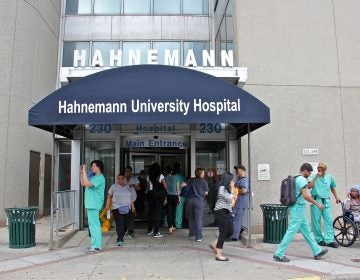Doctors: Malpractice rule change would drive up patient costs
Some doctors want to stop the Pa. Supreme Court from changing a rule tied to medical malpractice lawsuits.

Dr. Christopher Addis speaks to Republican lawmakers at a House Majority Policy Committee hearing Thursday, Feb. 14, 2019. (Screengrab)
Some doctors want to stop the state Supreme Court from changing a rule tied to medical malpractice lawsuits.
They say the plan would drive up costs for medical practices and patients alike.
The issue is where lawyers may bring personal injury suits.
Under current law, attorneys must file in the county where the alleged malpractice happened.
The court is considering reversing its own decision from 2002, a move that would let lawyers initiate cases in any county with a connection to that doctor.
Christopher Addis is an internal medicine doctor at Lancaster General Health. Addis is one of several doctors who spoke to GOP lawmakers at a house majority policy committee hearing Thursday.
Addis said if the rule is reversed, he could be summoned to court in Philadelphia, where Lancaster General-affiliated Penn Health is based.
“We are really separate hospitals, “Addis said. So I think the argument of saying we’re part of Penn, so we’re fair game to go to Philadelphia, really doesn’t hold water because we’re still separate cultures.”

Groups that oppose the planned rule change, such as the Hospital and Health System Association of Pennsylvania, have said it will motivate lawyers to file in Philadelphia or Pittsburgh because they have historically won more cases there and gotten higher payouts.
With widespread health system affiliations, almost any medical practice arguably could be tied to those cities, even if the alleged malpractice occurred many counties away, according to Dr. Danae Powers of State College.
“The consolidations that have taken place in the marketplace are going to exacerbate what was in existence in the late 1990s and 2000s, and I think what we would see, should this be changed now, is going to be way worse than what we saw then,” Powers said.
Powers was referring to what she said was the proliferation of medical malpractice lawsuits in Pennsylvania during that time, which lead to sky-high insurance rates. That drove doctors to other states, increased patient costs and, in caused shortages of specialists in some regions — all of which set the stage for the 2002 court ruling that now might be reversed.
Some trial lawyers say the medical community is mischaracterizing the potential rule change and that existing law gives doctors special protections other defendants in civil cases don’t have.
A public comment period on the matter is ongoing through February 22. However, a decision could draw on for months.
State Supreme Court Chief Justice Thomas Saylor said in a Friday letter to lawmakers that “a majority of the court” has agreed to wait for a report from the Legislative Budget and Finance Committee before before moving forward.
Opponents say they’re encouraged by lawmakers’ attention to the issue and the justices’ decision to delay action for now.
“The committee’s action today represents a win for Pennsylvania’s patients and families, whose access to care would be threatened if the commonwealth were subject to another medical liability crisis,” said Jeff Bechtel, HAP’s senior vice president, health economics and policy in a Thursday news release.
WHYY is your source for fact-based, in-depth journalism and information. As a nonprofit organization, we rely on financial support from readers like you. Please give today.





